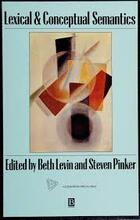Language and cognition have been explained as the products of a homogeneous associative memory structure or alternatively, of a set of genetically determined computational modules in which rules manipulate symbolic representations. Intensive study of one phenomenon of English grammar and how it is processed and acquired suggest that both theories are partly right. Regular verbs (walk-walked) are computed by a suffixation rule in a neural system for grammatical processing; irregular verbs (run-ran) are retrieved from an associative memory.
Publications
1991
How are words represented in the mind and woven into sentences? How do children learn how to use words? Currently there is a tremendous resurgence of interest in lexical semantics. Word meanings have become increasingly important in linguistic theories because syntactic constructions are sensitive to the words they contain. In computational linguistics, new techniques are being applied to analyze words in texts, and machine-readable dictionaries are being used to build lexicons for natural language systems. These technologies provide large amounts of data and powerful data-analysis techniques to theoretical linguists, who can repay the favor to computer science by describing how one efficient lexical system, the human mind, represents word meanings. Lexical semantics provides crucial evidence to psychologists, too, about the innate stuff out of which concepts are made. Finally, it has become central to the study of child language acquisition. Infants are not born knowing a language, but they do have some understanding of the conceptual world that their parents describe in their speech. Since concepts are intimately tied to word meanings, knowledge of semantics might help children break into the rest of the language system. Lexical and Conceptual Semantics offers views from a variety of disciplines of these sophisticated new approaches to understanding the mental dictionary.
AVAILABLE AT:
Amazon
Amazon UK
When it comes to explaining English verbs’ patterns of regular and irregular generalization, single-network theories have difficulty with the former, rule-only theories with the latter process. Linguistic and psycholinguistic evidence, based on observation during experiments and simulations in morphological pattern generation, independently call for a hybrid of the two theories.
1990
How do people recognize an object in different orientations? One theory is that the visual system describes the object relative to a reference frame centered on the object, resulting in a representation that is invariant across orientations. Chronometric data show that this is true only when an object can be identified uniquely by the arrangement of its parts along a single dimension. When an object can only be distinguished by an arrangement of its parts along more than one dimension, people mentally rotate it to a familiar orientation. This finding suggests that the human visual reference frame is tied to egocentric coordinates.
1989
In a recent paper, Chambers and Reisberg (1985) showed that people cannot reverse classical ambiguous figures in imagery (such as the Necker cube, duck/rabbit, or Schroeder staircase). In three experiments, we refute one kind of explanation for this difficulty: that visual images do not contain information about the geometry of a shape necessary for reinterpreting it or that people cannot apply shape classification procedures to the information in imagery. We show, that given suitable conditions, people can assign novel interpretations to ambiguous images which have been constructed out of parts or mentally transformed. For example, when asked to imagine the letter “D” on its side, affixed to the top of the letter “J”, subjects spontaneously report “seeing” an umbrella. We also show that these reinterpretations are not the result of guessing strategies, and that they speak directly to the issue of whether or not mental images of ambiguous figures can be reconstrued. Finally, we show that arguments from the philosophy literature on the relation between images and descriptions are not relevant to the issue of whether images can be reinterpreted, and we suggest possible explanations for why classical ambiguous figures do not spontaneously reverse in imagery.
